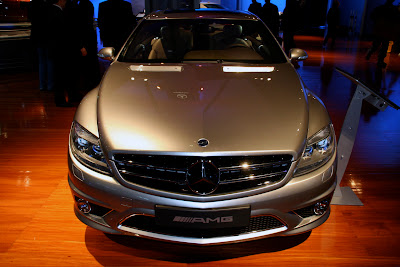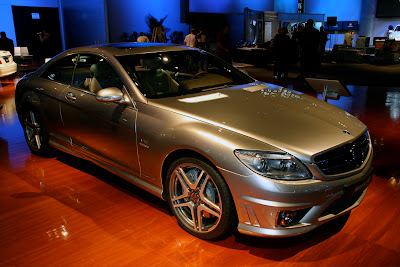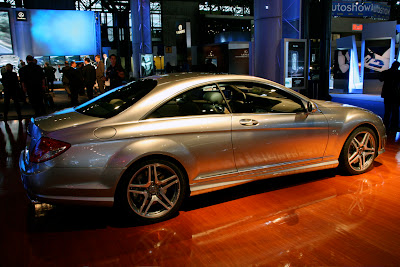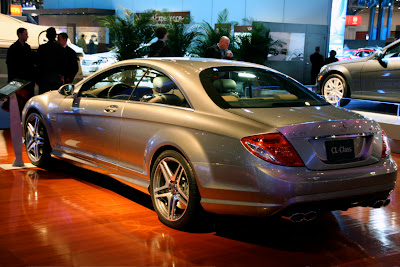
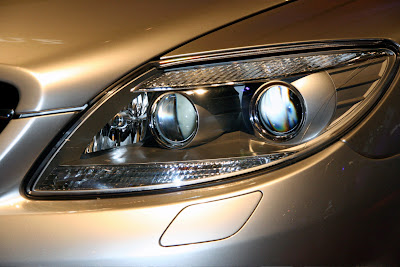


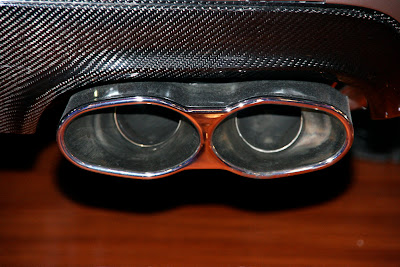
Detailed content:
Mercedes-Benz CL65 AMG MAKES WORLD DEBUT
Anniversary-Edition CL65 AMG Celebrates 40 Years of AMG Performance
NEW YORK – The 2008MY Mercedes-Benz CL65 AMG is making its debut at the New York International Auto Show, open to the public April 6-15, 2007 at the Jacob Javits Convention Center in Manhattan. The powerful version of the CL coupe powered by a twin-turbo AMG V12 engine is also special because it marks the 40th anniversary of AMG, the high-performance division of Mercedes-Benz.
The limited-edition CL65 AMG celebrates 40 years of AMG high-performance cars with a 6.0-liter twin-turbo V12 engine that produces 604 horsepower and 738 pound-feet of torque for zero-to-60-mph acceleration of just 4.2 seconds. The new CL65 AMG also features an AMG developed high-performance braking system that can bring the car to a stop from 60 mph in less than 116 feet!
Alubeam – Liquid Metal
The 40th Anniversary CL65 AMG is the first-ever production car finished in exclusive AMG Alubeam (Liquid Metal) paint. Stretched over the body like a metallic skin, AMG Alubeam paint shows off the compelling lines of the large coupe better than any conventional paint finish. Made possible by pigment particles that measure only 30 to 50 nanometers (conventional pigments are between 100 and 300 nanometers), AMG Alubeam reflects light more evenly and more intensely, and is protected by a clear coating with enhanced scratch resistance.
An AMG two-bar front grille, large under-bumper air intakes, air outlets on the front fenders and round fog lights dominate the front of the car. Distinctive skirts under the doors and V12 BI-TURBO lettering enhance the front fenders, while a muscular rear apron with a black air diffuser insert and twin V12-design tailpipes complete the eye-catching look of the limited-edition CL65 AMG.
Inside, the 40th Anniversary CL65 AMG comes with two-tone Nappa leather seats finished in diamond pattern stretching with embossed V12 logos in the front head restraints as well as a color-coordinated Alcantara headliner, complemented by genuine carbon fiber interior trim. Underscoring the exclusivity of this new vehicle, "40th Anniversary" lettering appears on the center console, and a "One Out of 40" badge is mounted on the handrest of the COMAND controller for the 40 CL65 AMG coupes designated as special edition anniversary models.
6.0-Liter V12 AMG Engine Redefines Performance
While the 6.0-liter twin-turbo V12 engine that powers the CL65 AMG produces 604 horsepower and an astounding 738 lb-ft of torque, the super-smooth twelve-cylinder powerplant is also ideally suited for relaxed cruising. The CL65 AMG's twin-turbocharged engine features a number of high-tech modifications. A precision-balanced longer-stroke crankshaft, larger-bore forged pistons and beefier bearings and oil-spray cooling system are but a few of the highlights. The twelve-cylinder engine is assembled by hand at the AMG engine facility in Affalterbach, Germany. The "one-man, one-engine" philosophy at AMG is symbolized by a signature plate on the engine that bears the name of the master technician who assembled the engine.
Stopping Power to Match Performance
To handle the high power output of the AMG twin-turbo engine, the front brakes of the AMG V12 model are equipped with high-performance twin sliding calipers. A world first, this new technology combines the advantages of a floating caliper – lower heat transfer to the brake fluid and enhanced comfort – with the performance of a large fixed caliper.
The CL65's composite brake discs measure 15.4 inches in diameter up front and 14.8 inches in the rear. These immense brakes are also vented and cross-drilled for effective cooling and short stopping distances, even from high speeds. At the rear, frame-type sliding calipers do the work. High-performance tires – 255 / 35 ZR 20 in front and 275 / 35 ZR 20 at the rear – are mounted on forged 20-inch AMG twin-spoke wheels – 8.5 inches up front and 9.5 in the rear.
While all CL-Class models are equipped with ABC active suspension that offers an unparalleled combination of ride quality and handling agility, the CL65 AMG is equipped with special AMG spring struts with firmer damping. Reworked dynamic systems such as ESP stability control and ASR traction control complement the enhanced chassis setup.
About AMG
The abbreviation AMG stands for Hans-Werner Aufrecht (A) and his partner Erhard Melcher (M), who founded AMG in 1967, and Aufrecht's birthplace of Grossaspach (G). Both had been employees of Mercedes-Benz and officially described themselves as "engineering, design and testing specialists in the development of racing engines." The fledgling firm initially based itself in an old mill in Burgstall (near Affalterbach).From its beginnings as an independent racing and tuning firm of Mercedes cars, Mercedes-AMG has grown into a supplier of exclusive high-performance cars, now with some 750 employees, an extensive model range and customers around the world. An integral part of the Mercedes-Benz organization, Mercedes-AMG has become synonymous with factory-developed high-performance vehicles. Far more than a tuner or marketing division, Mercedes-AMG is a self-contained entity responsible for all aspects of its vehicles, from development and testing to marketing, with some aspects of production shared with Mercedes-Benz facilities.
First Racing Victory in 1971
In its early years, AMG concentrated on building racing cars based on the Mercedes-Benz 300 SE sedan and competing in European touring car races. The first racing success came in 1971, when a Mercedes 300 SEL 6.8, modified by AMG with a 6.8-liter engine, captured an impressive class victory in the 24-hour race at Spa in Belgium, finishing in second place overall.
- more -
International Clientele Fuels Growth
The 1971 success proved to be the springboard for an enviable record on the track that formed a cornerstone of the AMG philosophy and continues to this day. However, AMG's success spread well beyond international motorsports. In the 1970s, the company began to offer high-performance tuning and individualization for Mercedes customers in Europe and other markets. The transfer of technology from motorsports into production cars already formed part of the company's philosophy. The company built its exclusive reputation by developing impressive technology and first-class quality on the back of its involvement in racing. AMG soon became the premiere Mercedes-Benz specialist in the world. Through the 1970s and 1980s, AMG developed a number of special high-performance models based on production Mercedes sedans and coupes. These vehicles incorporated modified, high-power Mercedes engines and race-proven modifications to the chassis and brakes, AMG light-alloy wheels and wider tires, resulting in fully developed, well-rounded high-performance packages.Strong demand for performance Mercedes-Benz vehicles in the late 1970s led to a steady increase in the number of orders received by AMG. The company outgrew its facility in Burgstall and moved to Affalterbach in 1978. In 1985, AMG opened its second factory and hired its 100th employee. AMG was now attracting customers from all over the world, including building one-of-a-kind vehicles for international clients. This experience strengthened AMG's reputation in the world of high-performance vehicles as builders of top-performance Mercedes-Benz cars. As an industry pioneer and trendsetter, AMG became committed to achieving and retaining a position as a world leader in terms of technology, design, and sales. Though AMG cars did not become available in the U.S. market until 1995 when the C36 AMG made its debut, word of AMG vehicles had already made its way into the U.S. enthusiast press. Most famous was "The Hammer" – a 1987 Mercedes-Benz 300E powered by a 360-hp 5.6-liter V8. The signing of the cooperation agreement with DaimlerChrysler AG (then Daimler-Benz AG) in 1990 marked a turning point for AMG. Under the terms of the agreement, AMG products could be sold at Mercedes-Benz dealers in overseas markets, significantly improving customer acceptance. Further expansion led to the opening of a third facility in 1990, and an increase in the workforce to 400 employees.
AMG Comes to America
When the C-Class succeeded the 190 series in 1993, AMG unveiled the first jointly developed vehicle – the Mercedes-Benz C36 AMG, backed by a full Mercedes-Benz warranty. Demand for this 268-horsepower, six-cylinder screamer was limited by production to just under 1,000 cars over a three-year period. In the U.S., the C36 AMG was followed in 1998 by the C43 AMG, the first V8-powered C-Class model. Customers clamored for more AMG models, so Mercedes-Benz and AMG responded with the E55 AMG, a 349-hp powerhouse that blended super-car performance with four-door Mercedes comfort. Fueled by this customer interest, AMG developed an array of top performance Mercedes-Benz models from the growing palette of Mercedes-Benz vehicles. AMG's brand success reached a notable milestone 1998 when DaimlerChrysler acquired a majority ownership in the company. U.S. customer interest in AMG models increased steadily, with sales of 7,500 AMG models in 2001. During 2002, the strategy of offering an AMG model as the top performance Mercedes-Benz in every model line was achieved with the introduction of the SL55 AMG – the first SL roadster AMG offered in the U.S. The source of the SL55 AMG's power, a new supercharged 5.5-liter Kompressor V8, was also installed in revised versions of the S55 AMG and CL55 AMG launched in late 2002. The 2007 model year marks the debut of the first-ever engine developed from the ground up by AMG, 6.3-liter naturally aspirated V8 delivering up to 518-hp (depending on the model).
Mercedes-AMG Today
On January 1, 1999, H.W. Aufrecht sold a majority shareholding in AMG, and the company was incorporated into DaimlerChrysler AG, allowing the newly founded Mercedes-AMG to benefit even more from DCAG's global resources. The highly specialized subsidiary has overall responsibility for the engine, transmission, chassis, brakes, aerodynamics, interior, design and sales and marketing of AMG-badged cars. Growth of the Mercedes-AMG product line has been supported by the opening of new production, development and showroom buildings at its Affalterbach plant. The engine factory, showroom and two development buildings, built and operational in 2003, have more than doubled the space of the facility from 199,000 to 426,000 square feet.
One Man, One Engine
The centerpiece of the recent expansion is a new engine factory, which produces 100 engines a day for the entire range of Mercedes-AMG vehicles. Work takes place on three floors across a total area of 107,000 square feet, and about 50 highly qualified master technicians work in the new facility. Mercedes-AMG follows a philosophy of "one man, one engine." This means that a single technician – identified by the signature plate affixed to the engine – is responsible for the complete assembly of an AMG high-performance engine from start to finish. After a technician assembles an engine, it is individually tested and then moved to a storage facility on the upper level. Flexible manufacturing processes allow the factory to quickly adjust for changes in demand for the various AMG models. A computerized data management system continuously optimizes engine inventory. In addition to engine manufacturing, the new production facility is home to plant management, quality control, production planning, and ordering and parts logistics departments.
AMG currently employs about 750 specialists in development, production and administrative areas. AMG develops each of its models, from the engine and driveline to suspension, brakes, chassis and aerodynamics. Each engine is produced and tested at AMG's headquarters in Affalterbach, and AMG models are assembled at the main Mercedes-Benz vehicle assembly plants.
